Domino Records imprint, Geographic is set to release the long awaited Pastels/Tenniscoats' album 'Two Sunsets' on September 7th. The record was recorded over the past 3 years, whenever the Japanese based Tenniscoats were in Scotland on tour. The record also features the likes of: Norman Blake (Teenage Fanclub), Bill Wells, Tom Crossley (International Airport) and Alison Mitchell. The first single, 'Vivid Youth', is a song penned by Gerard Love and Katrina Mitchell. The video was shot on 8mm and 16mm film by Blair Young.
Monday, August 31
Steely and Clevie
Jamaican legends Steely and Clevie discuss production techniques and their history at the Red Bull Music Academy:
Thanks to nobeahmon for pointing this out!
Thanks to nobeahmon for pointing this out!
Morning Music
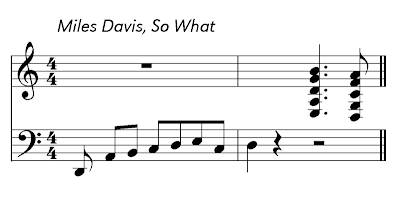
I just woke up, and first thing in the morning I almost always listen to jazz. One of my favorite albums to listen to in the morning is one we've spoken of before, and that's 'Kind of Blue' by Miles Davis. Coincidentally, this record is also a great one to study for you music theory geeks. Why? Because of the album's immense popularity, transcriptions of the songs are all over the internet. The song I want to showcase today is 'So What'. Like the rest of 'Kind of Blue', 'So What' is based on a modal scale or mode, in this case the mode is D dorian. The actual progression of the piece is the old 32 bar standard american pop song: 16 bars of D dorian, 8 bars of E flat dorian, and then back to 8 bars of D dorian.

Below is a video from 1958 of Miles Davis playing 'So What' along with members of the Gil Evans Orchestra and the mighty John Coltrane (whose own song 'Impressions' is a reworking of 'So What'.)
Quincy Jones once wrote to one of his many friends, "That [Kind of Blue] will always be my music, man. I play Kind of Blue every day—it's my orange juice. It still sounds like it was made yesterday." I couldn't agree more and that's why a lot of times I'm eating eggs and drinking coffee while listening to it. What's your wake up music?
Dub:
Miles Davis
Sunday, August 30
Piano Guy
We've gone into techniques on software, but we haven't touched theory yet on Resonant Filter. One of my favorite sources for music theory is Scott Houston, aka The Piano Guy from PBS television. His approach to music theory is refreshing and to the point. You can find his books many times in the sale section of most books stores and his videos are on YouTube. Here's one of my favorites:
and a great mashup by Coxshow:
and a great mashup by Coxshow:
Dub:
Music Theory
Saturday, August 29
10 Questions with Ed Bauman
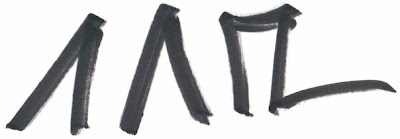
Ed Bauman, aka EditEd4TV, is a steadfast member of the Propellerhead's User Forum. When someone writes in with a technical question concerning Reason you can be sure Ed will lend a helping hand. EditEd also produced the fantastic "Reasonable Help", which has an updated version coming out soon. But what we've all really been waiting for is the DVD, "Understanding Thor", which we'll discuss in the interview. In a recent version of "10 Questions", when asked about his favorite patch designers, Tom Pritchard answered, "Special mention has to go to Ed Bauman, just because his patches are so technically accomplished and unbelievably useful." I couldn't agree more! I sent Ed a list of questions earlier this week and just couldn't wait to receive his answers:
- I know you're based in the Bay Area and saw on you Facebook page that you are part of a group called SFBARUG (San Francisco Bay Area Reason Users Group), that meets up occasionally (the last one was a jam at Peff's place!) I think this is so cool and I'm wondering how you guys got together and if this a regular thing?
The first time the SFBARUG met was many years ago, maybe 2005 I think? It was an idea that we had, I forget who came up with it, we all probably thought of it about the same time. I was chatting with Kurt about syncing laptops together and we decided that, well, since it worked on paper, theoretically and all, it should work in real life. We met at Darin "dbooty" Wilson's place in San Francisco. Mark Tarlton was there as well - Mark has a really cool PUF name: mark. We had a drum machine that served as the tempo master clock, sending MIDI out carrying MTC (MIDI time code) to a MOTU TimePiece I believe, where it split off to the 4 destinations we had that night, that being our 4 laptops. So we each set Reason to sync to this incoming MIDI signal, and we each used our own MIDI to USB interface to bring that MTC into our computers, and we each also used some form of USB controller to actually play the Reason devices. That first time, things went without a hitch, it just plain worked. Once sync was established we jammed without saying much to each other at all for something like 45 to 50 minutes, weaving drum loops in and out with bass lines and synth pads and all sorts of stuff, simply mesmerized. When we finally drifted off into a lull and faded out, we all sorta sat there in a state of, I don't know, it was just sorta... whoah... then we laughed because it was soooo cool. Since then we've had probably 6 or 7 jams just like this. Sometimes there are connectivity and sync issues, and it takes a while to get them resolved, but eventually we're up and running. The smaller jams seem to work best because having too many people together tends to lead to a bit of a wall of sound if we don't each pay attention to being sparse and/or non-dominating. We've also hooked up quite a bit to just meet and sit and chat over dinner. I think we'd prefer if it were a regular thing but it's hard for all of us to get our schedules lined up. Beyond the technology and music I've really enjoyed hanging out with Rick Silvestri (Blacktiger, another PUF regular), we've gotten together to eat dinner more often than we've jammed together, really super nice guy. This weekend I'm working on a video project with Tony "Cubricon" Dias. Outside of the San Francisco area, I've had dinner with EnochLight when I was in his neck of the woods, really nice guy, lovely wife/family. I'd love to travel to the UK and meet Tom Pritchard and Adam Fielding, those two are just incredible.
- what's your background as a musician? did you start with synthesizers?
Technically I'm not a musician (PUF regulars might remember that thread - oh brother) - lol. Way back in 1972 when I was 5 years old, I took organ lessons from my aunt Dolores. I learned all the basics about keys, scales, chords, and more. But after about 2 years I stopped taking lessons and from there I just trained my ear, just by myself. I'd listen to the Beatles, The Who and Led Zeppelin and just figure things out on my own, just on the Lowrey organ. Sometime in the early 80's I finally scraped together enough money, with the help of my dad, and purchased my first synthesizer, a Sequential Circuits Pro-One. I still own it, still works just fine. Some of the first things I did with the Pro-One, after experimenting like mad all the time and learning what everything did, was to recreate the sounds off the Lowrey Holiday organ (yeah, I still own that too, sad huh?) That's how I trained myself in patch creation and synthesis; I'd recreate those organ sounds as close as I could get with the Pro One - just a monophonic voice, but the techniques were all there. I think that's where I trained my ear to listen for layers, to listen for the raw elements of sound; strip away the effects and listen for tone, strip away the tone or filter and listen for the raw oscillator. If you can get there in some strange form of sonic mental reverse engineering, you can build up from there; pick the oscillator, set the filter correctly, and then everything else is somewhat extra, like amp and filter envelopes, effects, etc. So all along this whole process I learned not only how to reverse engineer sounds and textures, but chords as well. I have been really blessed with an uncanny ability to hear a chord and figure it out. It's really important to constantly train your ear, to hear a chord and recreate it, split the notes off into an arpeggio in your mind; everything you need is there and you just need to train your ear to hear the individual notes, to pick them out of the whole. It's a multi-stage process: you hear the chord, you mentally pull each note out in your mind, then you sing the notes back either mentally or with your voice while you fish them out on the keyboard. After my rock and roll roots I was introduced to progressive rock, and that's where the self-training was really pushed, as I learned chords and time signatures of tunes by Yes, UK, Happy the Man, Rush, King Crimson, Saga, and more. The UK stuff was especially challenging for the ear; figuring out the opening chords for "Danger Money" or the massive keyboard work in "Carrying No Cross" and "Presto Vivace" was pretty hard for a 16 year old; look those up on YouTube, those songs are great, though the studio versions are way better than the live stuff, even they couldn't pull it off live. I also taught myself Boston's "Foreplay", Saga's "Conversations", and "Carry On My Wayward Son" by Kansas - oh man, the days of free time are way behind me now!

- I know you've been on the PUF (Propellerhead's User Forum) since at least 1.9.2003 (from your statistics), when did you first hear about Reason and what attracted you to the program?
I think I've been on the General Forum and the PUF since 2002? Somewhere through the years the numbers got screwed up and everyone has a join date of 2003. And the total number of posts got messed up too, it's ridiculous how high it got, but I jumped off the General Forum and stuck with the PUF. I first heard about Reason when I worked at Apple between 1997 and 2001. My job there put me in touch with a lot of partnership and product managers. The music partnership manager at that time brought me Reason 1.0 one day. At the time I was totally into Bars & Pipes Pro for the Amiga, MIDI'd up to my Alesis Quadrasynth Plus Piano. I was trying to streamline my system for years, and this Amiga + Alesis combo was so much easier than all the MIDI gear I had before (SCI Pro One, Prophet-600, Drumtraks, Korg DSS-1, DDD-5, Kawai K3, K3m, PH-50), just me and my Amiga 3000 and my Quad+. Long story short, in 1999 I had L5-S1 ruptured disc surgery on my back. My days of lugging around gear were definitely over. I was seriously ready to throw in the towel, simply give up, there was so much technology, things were changing all the time, I couldn't afford a subscription to all the mags I wanted to read, it was too much, I couldn't keep up and felt like I was completely out of the loop and wasting my time even trying. I left Apple to start working at a place where I could pursue my video editing interests a bit more, editing medical videos. I eventually found the time to look at this Reason 1.0 thing my friend gave me. I didn't know what to expect at all. I remember looking at the screen for the first time, thinking "oh, how cute, it's like a rack, neat." Then I hit the tab key. Seriously, my jaw literally dropped, and I think I may have even drooled a little. I was ecstatic - real live cables I can move around and plug in and out. I knew right then and there that this would eventually be the ONLY thing I would ever use again. I found my way to the forums looking for help, and pretty soon I was offering help. I love helping people. When I was growing up, doing this on my own, I couldn't afford lessons or training at all, and in the video production world I found a lot of people protective of their craft, unwilling to share information or tips or tricks or even basic knowledge. Being stuck... I taught myself. So if I can answer a question on the forum and save someone the trouble that I went through, it's worth it.
- A lot of your patches are very technical and delve into some creative uses of CV and combinator patching, do you have a science background, and how did you go about learning to use Reason in such an idiosyncratic way?
No, no science background. Scientific I suppose, but not directly science. There's a science to creating patches, it's almost an art form I suppose. When I see a clever bit of programming I'm very impressed, I love it. I remember the first time I saw Shawn "Ogggy" Sunkel (a PUF member we sadly lost to a heart attack in July) use Thor's formant filter display to visually show an LFO pattern - that was brilliant. Or the recent 4 source audio crossfader by Shultz, another truly awesome idea. For myself, I suppose I learn from necessity. When someone says something "can't" be done in Reason, I like to find a way to get the job done. I think I first jumped into CV, believe it or not, by looking at some of Tom Pritchard's work in 2003. Up until that point I had no idea how to go about it. I mean, I knew how to use it in the real world with the Pro One and other analog gear I experimented with, but I never tapped into it at all with Reason 1.0 until I looked at some of Tom's work and thought, ok, what is he doing here? As I learned from looking at other people's work, I began to do it myself, reading threads on the forums and using those requests as launching pads for research. So yeah, I like a challenge, so I'll take those moments of impossibility and work at making a patch that accomplishes the task.
- Obviously we all know you use Reason, what else does your studio consist of? Do you use any other software or hardware in your music production?
No, It's all Reason. The only hardware I own is in support of Reason: Emu XBoard 25, Evolution MK-461c, Keystation Pro 88es, Behringer FCB1010, Korg nanoKontrol, Yamaha BC3 w/MIDI Solutions Breathalyzer, Line6 UX2, and three MIDIsport 2x2 interfaces (actually ones an authentic Steinberg version). None of that does anything on it's own, it's all used to control Reason. In the studio I also have a UREI 6230 power amp and two JBL 4410's for those rare moments when I feel the need to be loud. I have some ancient Yamaha MS10 (yeah, MS, not NS) that were part of a 4-track system, I use them for rough monitoring when I edit video. On the video side I have a DSR-30 DVCam editing deck, and some other DVD and DVR stuff, all converted to HDMI and routed to one of my Dell SP2309W monitors. I have two of the 2309's, hooked up to a fairly new Mac Pro, so the monitor on the right serves dual purpose between the Mac and the video gear. All of my Reason work is done on my MacBook Pro, but now that the Mac Pro and dual monitor setup is here I'll switch over to that system soon, especially with any Record work I'll be doing. I just need to get a rotating monitor stand so I can put one of the Dell's at a 90˚ angle to see the full mixer, top to bottom. But I still like to work on the MacBook Pro to get out of the office/studio, wander the house, sit in the livingroom, etc.
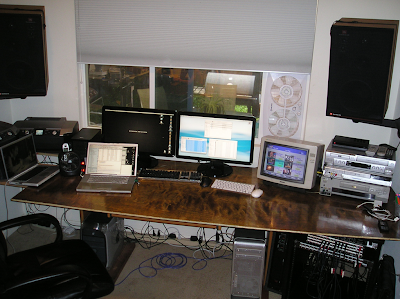
- I know you work professionally in the video editing field (hence the name EditEd4TV) and I've been to your website and your videos are very impressive. Do you sometimes get burned out on using a computer creatively for both work and leisure?
Oh yeah, definitely, I get tired of sitting at a computer all - day - long... ugh, it's exhausting sometimes. It comes and goes in waves; the workflow, my interest, etc. Sometimes I can put in 8 or 9 days non-stop, 5:00 am to 11:00 pm just editing video, trying to get projects wrapped up and delivered, and then I hit a wall where I just don't want to look at a screen anymore. Literally, I've had nights where I dream about Final Cut Pro errors all night long. Then I wake up and go sit at my desk with Final Cut Pro all day long, then it's back to bed for more nightmares - hah! I joke with my wife Lana about wanting to be a park ranger, where the only thing I would have to do all day is welcome people to the park, wear my cool hat, avoid bears, shoot my index fingers at little kids and call them "partner", etc. Then I found out that being a park ranger is no easy task. So yeah, I get burned out, especially when I have a string of other people's projects all over the bay area, sometimes all the way up to Sacramento, sometimes all the way down to Bakersfield, sometimes out of state too, and then I come home and sit at a computer for a few hours working on projects that I'm producing, and then beyond that I have to take care of all the computer work that goes into being self-employed, and then I finally get to work on something like "Understanding Thor" or "Reasonable Help", and then, maybe then, I can maybe just put on my headphones and enjoy playing some music, just for fun. Those moments are rare, so I try my best to make the most of it.
- I just picked up "Reasonable Help" and was impressed with the amount of documentation included with the .rns and aif files. (I particularly liked the MixerChannelMuting.rns and DizzyPanning 1 & 2 files.) This first version of "Reasonable Help" was created back on Reason 2.5, before the advent of combinators and the mighty Thor. Now I know you are currently working on a new version of "Reasonable Help" and am wondering what kind of tips and tricks we can expect with this updated version seeing as Reason has advanced so much since the last edition?
There is a LOT going into the new version, I'm very excited to get it out there. Honestly, if you're a regular on the PUF, you've seen about 90% of this stuff before, BUT, almost all of it has been revamped, Combinator knob and button functionality has been changed and improved, so... all sorts of things are new, so really, you've probably only seen 40% of this stuff. Plus, all of this is coming with PDF documentation that's way better than the last version. I'm hoping to have the PDF documentation work hand in hand with the demo aif files, as well as the Reason files themselves, so, keep your fingers crossed. It'll almost work best if you work from the PDF document, where you can do key word searches, find what you want, click on a demo aif file to hear what the file is supposed to do, then click on the rns file to open it in Reason for your own use. Not sure if all that is possible, I have a bit more research to do, but I think that may be the route I go with. Some new cool stuff in the next version: 1 Finger Jazz Band, 7 ReDrums, Analog Delay, Analog Synth Latch Mode, Auto Fader, Car Radio, Channel Checker, Heroic Pad, Keyed Layer Selector, Live Pitcher, Noise Gate, Strummer, The Antiquator, and more.
- The MP3 clips on your website really run the gamut of musical genres. From the ambient electronica of the track "Drive" to the hip-hop dirty finger funk of "I live in the Projects". What music inspires you personally?
Hmmm... I grew up listening to your basic top 40 rock and roll through the 70's, and 80's, so I was raised with the Beatles, Led Zeppelin, Van Halen, AC/DC, Yes, Genesis, and of course all the 80's stuff fer shure fer shure. I got into progressive rock and listened to the bands I mentioned earlier. But I also love thematic motion picture soundtracks from the likes of Alan Silvestri, Hans Zimmer, James Horner, Jerry Goldsmith, and of course, John Williams. I also love the work of Debussy, Aaron Copland, Holst (oh how often has "Planets" inspired others?), and more. But for pure inspiration it's almost always cinematic orchestrations, they're always so moving.
- My last "10 Questions" was with Tom Pritchard, who named you as one of his favorite sound designers in Reason. Who are some of your favorites?
We've heard great stuff from Tom of course, but there's also Jeremy Janzen, Dave909/Sample Basement has excellent work, Exode, KikBack's MPC stuff, Xsynth (he has something new coming this December I believe). As far as song composition, Tom Pritchard and Adam Fielding are my favorites, they both do such wonderfully excellent work. I long for the day that I can dedicate so much time to working on one of my own songs, but life is busy and composition has taken the back burner for now.
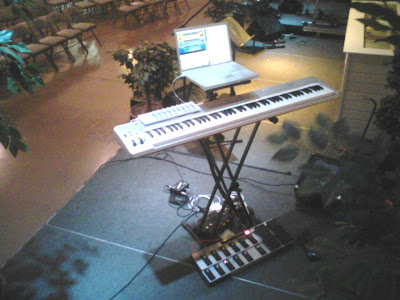
- It seems like a lot of the patches you make begin with someone on the PUF asking if a particular sound/effect can be achieved in Reason (see TrifonicPercussive), what are your favorite type of patches to design and why?
I like making patches that end up being a smaller part of a larger whole. I love making the "ReCover" files, where my initial intent is to provide just a synth patch, but I end up recreating the whole song. But I think I enjoy utility patches the best, where it's not really a sound but more of a supportive tool. For example, I just finished creating a Combinator that has this great function behind one of the buttons: you press it once and it advances Thor's step sequencer one step (no big deal), but when you turn off the button it advances Thor's step sequencer one step again. Sounds simple enough but it wasn't as easy to program as I thought it would be. After I found every "simple" idea resulted in the two desired results canceling each other out (no step advance at all), I had to find a new way to do it. I incorporated the solution into my NoiseGate/UnGate Combinator (which works very well by the way) and used this technique to advance delay ms via the step sequencer's curve 2 value for a compensation delay, but that portion of the design can easily be lifted and used in other Combinators. My hope is that people will take these patches I make and split them out and use portions for their own use. Those "utility" type patches are my favorites, as it's not just a sound, it's a tool, and being the catalyst for someone else's imagination makes me very happy.
- My final question is on another project I know you are currently engrossed with and that's "Understanding Thor". I've seen some demos on-line and it looks fantastic. I like that you are going into minute detail of every one of Thor's functions... because I know that when I watch tutorials, even when it's on a topic I think I know back to front I usually walk away with a new understanding and thus am really looking forward to this tutorial DVD on Thor, a synthesizer with so many possibilities. Some questions about it: What kind of release date are you shooting for? how long is this video going to be? are you planning on including documentation, .rns files, etc.. with this series as well?
Oh boy, do we have to talk about the release date? OK, sheesh... the original release date was supposed to be December of 2007 I think - hah! After I realized how intense I was making this video, I knew there was no way it was going to happen. I stopped taking pre-orders because I didn't want a massive horde of angry customers wanting to kill me. I worked on the project as much as I could but the freelance video production business really picked up and I ended up with no time to work on the Thor project at all. I'd spend so much time away from it that I'd have a terrible time trying to ramp back up to speed - it's so confusing, so many Final Cut Pro layers, sometimes up to 19 or 20 layers at a time. I was originally editing this on my MacBook Pro, with the intent that I'd be able to go portable with Final Cut Pro and edit anywhere I want. Ultimately this was a bad thing as it was limiting to work on a small 15" screen. I didn't realize how limiting it was until I finally shoved the whole project over onto my new edit system a few months ago - working on dual 23" monitors has made a huge difference, plus the render time on the new system is great as well. The terrible economy has been good and bad; I now have the time to work on this stuff, so my new deadline is December of 2009, but the downside is I'm not out and about making money doing freelance video because the normal workload has dwindled off to somewhere around 25% of normal... 2009 has been really bad. But back to Thor... as of right now, I have the entire introduction completed, the entire front Controller Panel completed, and a good portion of the Voice section of the Programmer Panel completed. Just this portion alone is already 55 minutes. By the time I get through the rest of the Voice section (more filters, ADSR envelopes, LFO 1), as well as the Global Section and the MBRS (Modulation Bus Routing Section) and the Step Sequencer, and the back panel connectivity... I think we're looking at well over 2 hours of content, probably closer to 3 hours. Yeah, that's a long video. My goal is to provide this with the entire script as as PDF file, verbatim, word for word... I think it'll be about 100+ pages. The script won't have illustrations, but it will have chapter markers for the DVD, so those could be used as a reference when watching the final product. So, you could pretty much use the PDF file as a Thor exclusive user's manual. It doesn't go into extensive detail in some areas (I'm not going into über geek mode on FM, for example, because it's just way over the top and beyond the scope of not only this video but most people's interest as well), but in most areas it goes into more detail and/or clearer explanations than the provided documentation from the Props. There's only so much you can do in print, and I'm trying very hard to make my visuals as graphic as possible; simple to understand, conveying concepts in simple ways that make it easy to understand. My hope is that someone can watch "Understanding Thor" and break through any barriers or anxiety they have about it, guided through the graphics and explanations. I want people to have many "ahhhhh... NOW I understand!" moments when they watch this. There probably won't be any included rns files, since it's very basic stuff I'm showing on screen, the actual patches would be boring instructional level stuff, but... if "Understanding Thor" does well, the plan is to release the next video in the series, which would be "Programming Thor" - that project would cover 12 to 15 different patches, from scratch to finish. If anyone wants to follow along on the progress of "Understanding Thor" and "Reasonable Help 2009", look up "EditEd4TV" on Facebook. I'm posting demo videos there and giving away a few Combinators now and then too.
Thanks for the great interview Ed!
Stay tuned in September, for the next edition of "10 Questions"...
Dub:
10 Questions,
EditEd
Friday, August 28
DJ AM R.I.P.
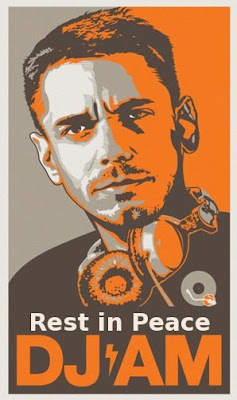
DJ AM was found dead in his NYC apartment this afternoon from an apparent drug overdose. A man perhaps more famous for the list of actresses and models he dated than for his music, DJ AM's most recent musical endeavor was a pairing with Blink-182's drummer Travis Barker. DJ AM, real name Adam Goldstein, had spoken at length in interviews of his past drug problems and escaped from a near fatal plane crash in 2008. His body was said to be surrounded by prescription pill bottles and drug paraphernalia. R.I.P.
Preparing record to ship
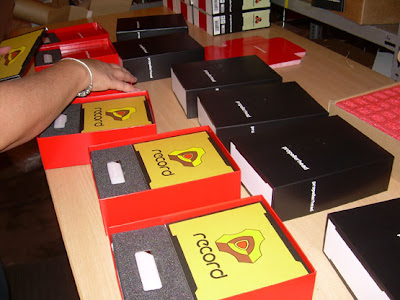
Have you pre-ordered your copy of record? Less than two weeks away! 9.9.9
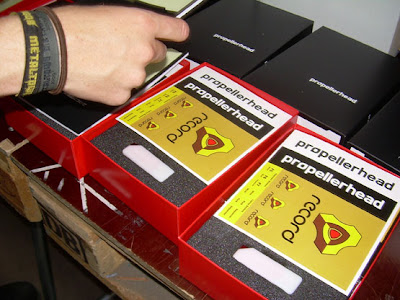
Those look like stickers to me!
Dub:
record
New Reason Wizardry Released Today!
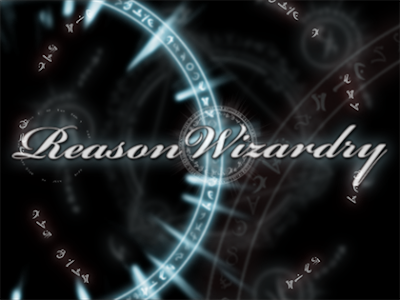
The brand new edition of Reason Wizardry is now out! This new issue, narrated by Nucleus Soundlab CEO Jeremy Janzen, has some really cool sound design tricks done with Oscillator Sync as well as unique CV routing capabilites in combinators with Thor... and that's just in the first 10 minutes. If you are into sound design and use Reason you must pick this up!
Dub:
Nucleus Soundlab
Nathan Larson on Soundtracks
Nathan Larson is a composer specializing in film music, who got his start playing punk rock in the late 80's & 90's; in bands like Swiz and Shudder to Think. His film work includes 'Boys Don't Cry', 'The Woodsman', 'Choke' and 'Velvet Goldmine'. Here's an interview from a few years ago, on which he speaks of composing for film:
Thursday, August 27
Audiomedical Laboratories
Neurosonics Audiomedical Labs Inc. from Chris Cairns on Vimeo.
More info:
neurosonicsaudiomedical
Thanks to Dioxide for posting this on the PUF.
AutoTEASPOONer combi

I needed a picture for yesterday's post on the "Shift" key and pulled up an old combi from the depths of my archives (which when your blog is just over two months old, means last month.) The combi I pulled up was one that I'd posted on Reason Patch A Day under the name "AutoTeaser", and after playing with it a bit I thought it could use a little changing. Here's the original blurb I wrote about it on RPAD:
"This effect really needs to be set for whatever piece of music you're using it on, which is fairly easy. Just flip the back side around, turn off the CV on Rotary 3, and rotate thru the settings finding one or two glitches for each matrix pattern in the combinator. The Pitch Bender on this one switches MOD A (which controls the matrix pattern changes.) It's a nice way to play with stutters fairly easy, and while MOD B is sweeping the delay playing with the knob, Rotary 3, still changes up the sound a bit. I'd recommend switching the Scream settings to different patches depending on what you are going for...."
So what's changed? Number one the Mod Wheel was set to control the rate of MOD A, now it's set to sweep thru MOD B's curves, which I think is much more useful. Also the Scream patch is now set to a Lo-Fi Tape patch that I stole from Tom Pritchard (instead of the glitchy digital one in the original.) And finally the name's been changed to AutoTEASPOONer. It's one of the patches that I made inspired by SquareWave Parade's Teaspoon effects device. And finally here's the combi download link:
Autoteaspooner
As well as an audio example featuring a rex file from the latest Gruss Pack:
Enjoy! And make sure to stay tuned for a new edition of "10 Questions" later this month with a surprise guest you won't want to miss...
Dub:
Reason
Modular Synth Bassline
"VCO-2RM sync patch with pitch modulation on the slave oscillator. The adsr decay and release was varied according to the pitch and emphasis from the A-161. The pitch variations were established using primarily the A160/1 with some influence from a S&H LFO mixed in. Then a four note sequence went to the master oscillator using the A-152. Then the M15 was added using a ringmod, with the same four note sequence going to the M15. Bass kick was added using the MMF-1 with M10 input. Hihat is A-117 amplitude modulated with A-143-3 square using the VCA-4MX. The signal is then level emphasized by the bass kick signal using the MX-4S."
Check out more of Doug's videos HERE.
Dub:
Modular
What's going on with PureMagnetik.com?
After yesterday's Michael Jackson post, I thought we'd create our own music software conspiracy theory. Now this idea came while I was perusing the internet and found this posted on the PureMagnetik site:

Do companies generally go off-line for a week? In my experience they usually create a mirror site to test problems. Unless of course something big is coming! A few months ago Kamoni posted an update on his site showing a picture of a delay plug-in he was designing for PureMagnetik. This update is mysteriously absent from his site now. Ta-dum! Now I could be wrong, but I believe PureMagnetik is about to launch a new monthly plug-in subscription service, much like their current service for Ableton Live packs. We'll know for sure on September 1st, when PureMagnetik comes back on-line.... just remember you read it here first!
UPDATE: September 1. Puremagnetik is back on-line, all that seems to have changed is they have a new pack 'Microtron 2' and they've taken down the lackluster 'Vox Box' pack from a month back. Still no mention of the delay plug-in Kamoni was working on.....

Do companies generally go off-line for a week? In my experience they usually create a mirror site to test problems. Unless of course something big is coming! A few months ago Kamoni posted an update on his site showing a picture of a delay plug-in he was designing for PureMagnetik. This update is mysteriously absent from his site now. Ta-dum! Now I could be wrong, but I believe PureMagnetik is about to launch a new monthly plug-in subscription service, much like their current service for Ableton Live packs. We'll know for sure on September 1st, when PureMagnetik comes back on-line.... just remember you read it here first!
UPDATE: September 1. Puremagnetik is back on-line, all that seems to have changed is they have a new pack 'Microtron 2' and they've taken down the lackluster 'Vox Box' pack from a month back. Still no mention of the delay plug-in Kamoni was working on.....
Dub:
Kamoni,
PureMagnetik
Wednesday, August 26
Reason Tips Everyone Should Know #1

Okay, enough off-topic posts for the day. This is the first post of what is going to be known as "Reason Tips Everyone Should Know" (hence the title.) Some of them are going to be obvious to those of you that have RTFM, but I think they should be noted just in case. #1 is something that I didn't know for at least a good month or two of using Reason, and that's the use of the "Shift" key.
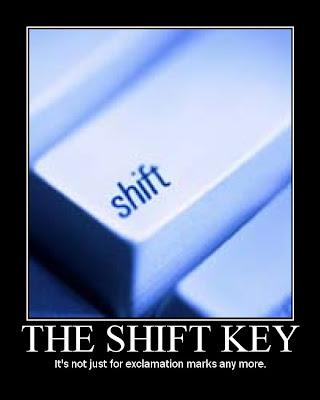
When adjusting parameters the "Shift" key enables you to move in more microscopic steps. This comes in very handy when working with combinators. I know because I've tried to match non-synced DDL-1s for stereo delay lines in a combinator before without realizing this basic function. What are your Reason Tips that you think everyone should know?
Dub:
Reason Tips
Dead man walking?
A video has been circulating the internet in which Michael Jackson appears to jump out of the back of a coroner's van. I guess it was bound to happen. Get ready for the next 50 years of Michael Jackson sightings. I for one think he should form a band with Elvis & Jim Morrison. Here's the video:
And if you get a kick out of bizarre conspiracy theories like I do, check out Illuminus Theo.
And if you get a kick out of bizarre conspiracy theories like I do, check out Illuminus Theo.
Sen. Edward Kennedy R.I.P.

Edward Moore "Ted" Kennedy - February 22, 1932 – August 25, 2009
Ted Kennedy died yesterday, succumbing to the brain cancer that had troubled him for the past year. He was the last living connection to the Kennedy dynasty and a constant reminder in the Senate to what might have if his brothers hadn't have been shot down in their prime. Regardless of how you feel about his politics you can't deny that he was a champion for the poor, civil rights, and the working class. Perhaps his life can be summed up best with his own words at his brother Robert's graveside:
"...to be remembered simply as a good and decent man, who saw wrong and tried to right it, saw suffering and tried to heal it, saw war and tried to stop it."
Rest in Peace and may you join your brothers in heaven.
And to tie this in with music, here's Sen. Orrin Hatch's song written as a eulogy:
Tuesday, August 25
Hefty 10 years in Berlin Video
Hefty Records is one of my favorite record labels. Based in Chicago and ran by John Hughes III, son of the late filmmaker John Hughes. Hefty has issued many remarkable albums by artist such as Telefon Tel Aviv, Eliot Lipp and Retina.it, to name a few. 3 years ago Hefty threw a 10 year anniversary party in Berlin and yesterday rtntsy6 posted this video on-line of the event. So of course I'm posting it!
BTW, if you aren't familiar with Hefty's output a great place to start is with Hefty Digest. A two disc set, featuring one disc that's a greatest hits of sorts for the label, and the second a mixtape done the phenomenal Prefuse 73.
BTW, if you aren't familiar with Hefty's output a great place to start is with Hefty Digest. A two disc set, featuring one disc that's a greatest hits of sorts for the label, and the second a mixtape done the phenomenal Prefuse 73.
2 beats by Mr. Blunt Pack - Reason Tutorial
Russian Hip Hop aficionado, Kirill aka Mr. Blunt Pack, laying down a couple of beats in Reason:
ЗОЛОТО И В ГРЯЗИ БЛЕСТИТ
ЗОЛОТО И В ГРЯЗИ БЛЕСТИТ
Monome Jealousy
I bought a Monome when they first came out and really dug it for the first 3-4 months. Then I started to feel like everything I made with it sounded the same.... so I ended up selling it. I don't generally miss it, but every once in a while I'll see a video and wish I still had one around. Here's a couple of clips which inspire that feeling:
&
64 (Video) Fingers from Charlie Visnic on Vimeo.
"This is a demo video of my app 64 (Video) Fingers. Modded from Dovemouse's 64 Fingers you trigger video and audio clips from the monome. Enjoy!"
&
edison.... new set up....! from edison on Vimeo.
Dub:
Monome
Monday, August 24
New DCAM Cypher Video
Has anyone picked up DCAM yet? I've always been impressed with FXpansion's quality and these look like quite a set of synths. Here's the latest tutorial video on one of them called Cypher, which is supposed to be a futuristic take on "analogue FM" synthesis:
Dub:
DCAM
Tennis Ball - Ableton Sample Tutorial
Art G from G-force beats shows the different sounds one can achieve with the sounds of a Tennis Ball in Ableton:
Dub:
Ableton
Dr. Rex Octave Fun

One quite simple trick to breathe new life into Rex files is changing the octave. But if you read this blog regularly you know I don't just stop at simple. So today we're going to talk about controlling the octave of Rex files in Dr. Rex. To get started find a Rex loop you like and hit the "PREVIEW" button on Dr. Rex. While the beat is looping try twisting the Octave control dial ("OCT" dial just below the "OSC PITCH" banner) to find which octaves sound best to you. Once you get an idea of that it's time to set-up a combinator. To do this left click on your Dr Rex and choose "combine". Now that you have yourself a combinator you'll need to create a Matrix Pattern Generator (but when creating the Matrix make sure to hit the "shift" button on your computer keyboard, because we don't want this controlling either the combinator or Dr. Rex just yet.) But we'll leave the Matrix be for now.

Okay, you'll want to open up the combinator's control surface at this point, by hitting the "Show Programmer" button. Inside of the programmer, next to Rotary 1, assign "Osc Octave" by clicking on the middle space. Once that's picked you'll notice the "Min" and "Max" amounts are automatically set-up for 0 to 8. You'll want to assign these to the lowest octave you liked the sound of and the highest (I've found that I usually like my "Min" on 2 or 3 and "Max" on 5 or 6.) Once you've chosen your Octave spread in the programmer that can be closed. Next hit "Tab" (on your keyboard), and on the backside of the combinator drag the CV cable from the Matrix's "Curve CV' out to the Combinator's Rotary 1 input. With this in place turn the dial next to Rotary 1 all the way to the right. You'll also want to switch the Matrix from "Uni-polar" to "Bi-polar" (the black switch two sockets over from "Curve CV').

Now our combinator is set-up and it's time to draw in patterns on the Matrix! Flip your rack back to front side (using the "Tab" key again) and switch the Matrix from "Keys" to "Curve" (switch just to the left of Matrix LCD.) By default the Matrix is set-up on 16 steps with all the bars in the pattern set downward to the bottom. I generally will draw these bars into the middle and then play around with the settings until I find something I like. Try different steps and resolutions as well, the real fun is in the exploration! If you find multiple patterns you like, you can always use the different patterns in the Matrix to store them and set up a knob on the combinator to switch between them (like in the combinator I've set-up for you on the bottom of this post.) Another option besides a Matrix is using a LFO. Either the one onboard in the Dr. Rex or by creating a Malstrom and using their built in Mods. You set this up in a similar fashion, by dragging the CV cable from the LFO/MOD out to the Rotary 1 input. Dig in!
Here's an audio example:
Audio example with 2 bars regular, 2 bars with octave shifting, 4 bars with bass accompaniment (bass patch courtesy of Reason Patch A Day, with Scream tube amp setting.)
Below's a combinator I've set-up to get you started with multiple patterns. Just press "PREVIEW" on Dr. Rex (inside the combi) and play (space bar) to check out the patterns. Or use it as a template and choose your own Rex file. Check it out:
Octave Rex
Dub:
Reason,
Reason Patch A Day,
Rex files
Sunday, August 23
Trifonic Synthesis
Adam Fielding, whose own music I greatly admire, mentioned today on the Props forum, how much he's digging the Trifonic album "Emergence". Which made me think I should look into them a little further..... Now for those of you keeping score, I did post the stellar video for their track Parks on Fire recently; but I hadn't yet fully explored their music. So this afternoon I went to the Trifonic website and found that you could not only listen to their entire catalog, but embed it. So naturally, I thought I'd share:
Dub:
Trifonic
Saturday, August 22
10 Questions with Tom Pritchard

Tom Pritchard, aka Stompp, is one of my favorite sound designers for Reason. His work for Nucleus Soundlab on Synthetic Kits and Filter Research is stellar, and if you haven't picked up his latest free refill, Wonderfill, you need to get on that asap. Now I sent Tom a list of questions and he answered them all, so while this is called "10 Questions", there's a couple of extra this time round.....
- first off, where are you based and what's the music scene like there?
I'm in South East London - I don't actually have a great idea as to what the music scene is like where I live, but I'm quite close to central London, so when I do go see something live it tends to be there; the last gig I went to was to see Biosphere (and I think BJ Nilsen) play some of their ambient stuff. Recently I've missed opportunities to see Squarepusher and LFO perform live, there's some great stuff about. Loads of jazz and classical and all sorts too.

-now that we've gotten that out of the way, there's quite a few questions I want to ask you, sound design questions are certainly some of them, but first I want to ask about your own music. I've checked out your Facebook page and really enjoy your tracks. I'd put them somewhere in the shoegaze/electronica genre... shoetronica? I'm wondering what equipment, both software and hardware you use when making your own music?
Thanks on the tracks, great to hear that you enjoy them! :) Shoetronica... I like that! I have a few different projects on the go, all of which use totally different equipment. Everything on that Facebook page is made almost entirely in Reason. I have a couple of other softsynths, and every now and again I sample patches from them and use them in Reason (mainly Albino 2 presets and my own Absynth 3 programming). But 95% of the stuff on that Facebook page is Reason. The other projects are a mix - all the hardware in that studio photo has never been used in any of the tracks that are online - I have it because sometimes you need a change of scene, so one day I'll write a track in Reason, the next I'll do some improvisation with the hardware, sometimes I'll just write something in ReBirth or using Korg's DS-10, and I have this experimental project called Eigenlicht which makes extensive use of things like granular synthesis and waveshaping in Absynth. I only release a tiny amount of the music I record. It just keeps things fresh, so I don't get fed up with working in one environment. It makes you think about how you write too - the stuff I make with the hardware is totally different to my main Reason work.
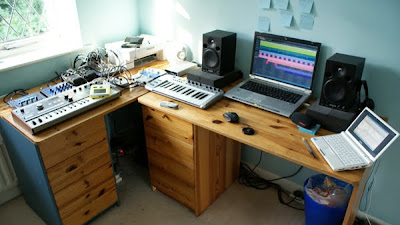
- as both a sound designer and a musician that composes music, do you sometimes come up with a patch and think, "oh, I've got to keep this for myself?"
Most of the patches in my free ReFills are actually patches I've made specifically for tracks, and sometimes I think to myself "this sound is really integral to this tune, maybe I should keep it under wraps", but I love to share, so usually I let them go. If I have a sound in a track that I haven't stuck in a ReFill, it's more likely to do with that sound relying on too many other elements in a song - like being particularly sensitive to specific notes and rhythms or being compressed with other parts - so for instance I couldn't recreate any of the sounds in August in any useful way in Combinator form because there's so much layering and compression there that the sounds just don't work on their own. :)
- I really love the track "Standing on the Shoulders of Giants" on your Facebook page (I'm a sucker for any track that features the sound of a radio being tuned between stations.-) Do you have any albums out and/or a website where people can download your music?
Awesome! Thanks. :D I used to have a collection of tunes up for grabs called 2008 Collected - all of the tracks that were in it are on my Facebook page. I moved all of my music to Facebook from another site so that I could do all of my online stuff under one website - the only websites where I have any kind of presence are Facebook and Propellerheads.se (anywhere else and it's someone else who decided to stick an extra P onto Stomp). Unfortunately, I didn't realise you can't download from Facebook until after the move - I should really sort that out. I'm always happy to send people tracks if they want an MP3 though! Or even a Reason file. :) To be honest, I kind of have a love/hate relationship with my music. I write music purely for fun, so often concerns about how it's mixed are thrown out of the window while I'm working on it - sometimes I feel a bit embarrased by the quality of my production and composition, and take my music down as a result. I hear what other people are doing on the forums, people like Adam and Josh and Mike (Avatar One) and it's just so professional and so well thought through and beautifully written, and then I hear guys like Luke Vibert use Reason and I think "man, he can do that... and I can only do this... I should pack it in". I never will pack it in, I enjoy it too much, but it's that sense of "oh wow they're all so good" that makes me think twice about putting stuff online. I remember when I was just starting out and thinking "OMG THIS IS AMAZING" and you come back years later and think "oh how did I think this is good?" so I wonder if I'll come back in another few years and think "oh the stuff I wrote in 2008/9 is awful". But then I was 14 when I started out, and I'm 21 now so I'm sure I've made SOME progress in 7 years!
-what's your background in music? did you start off playing synths or another instrument?
I've long had an interest in recording - since I got this My First Tomy tape recorder when I was little. I tried learning piano for a bit, but I gave up as I found it too dull (my sister is now a Grade 8 pianist and when I hear her play I wish I'd kept it up). Then one day a friend of mine showed me this Playstation game called Music, and it was amazing - we used to jam and string together loops and just have a great time, it made music fun again. I ended up taking music GCSE at school, and my school had a little room with some synths in it - an old Proteus 2000 and I think a Korg M1 and an old Lexicon reverb; I didn't write anything decent there but I got the hang of things like MIDI sequencing. I wanted to do it at home, somehow ended up finding out about Reason, and from then on just got more and more into the software. I've only picked up the other software synths and hardware in the last couple of years, for a long time it was just Reason.
- what music inspires you?
I'm tempted to list everything, but I don't want to send everyone to sleep if I haven't already - so mostly downtempo, atmospherc and unusual electronic music. Stuff I'm particularly keen on includes Oval, Brian Eno, LFO, Boards of Canada, Bibio, Christ. (Christopher Horne), Luke Vibert, Darrel Fitton (aka Bola & Jello), Aphex Twin, Voafose, FlyLo, Clark... just about anything released on Warp, Rephlex, Planet Mu, Ninja Tune, Benbecula, Thrill Jockey etc... I like more dancey stuff too, so Chemical Brothers, Klute, Propellerheads - basically if it's been in any of the Wipeout games I love it, that inspires tracks like Vector. Some of my friends write music too which is always amazing - Adam Fielding and Joe Rhead in particular, both of whom I'm sure have great musical careers ahead of them, always inspire me. I love a lot of classical music as well, Ravel and Debussy are my classical heroes. Oh I nearly forgot Vangelis! Probably the very first electronic music I really got into, the Bladerunner soundtrack is still one of the best albums out there today. I couldn't pick a favourite artist or album, but I think Memories of Green is my favourite track ever. Just so astonishingly beautiful.
- how did you get into sound design?
All thanks to Reason and wanting to make sounds like the ones I was hearing all over the place in electronic music. At first I used to just stack hundreds of Screams and RV-7000s together and make this terrible noise, and for a long while I was just twiddling knobs with no idea of the outcome - I actually wrote some really cool music, ambient music doing that! But over time I just wanted to be able to make specific sounds so I taught myself how to use synthesisers, with a lot of help from guides in magazines like Computer Music. One day I realised some of the sounds I was making were pretty cool and thought it would be nice to share them so that's when I released my first free ReFill, it's still on the Props site I think.
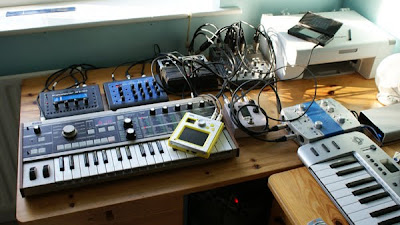
- I know your work primarily from NSL's Synthetic Kits & Filter Research refills and only recently put two and two together that you also release refills under the alias Stompp. Do you do sound design work for other platforms besides Reason and/or any other companies besides NSL?
Yes, a little. Most recently I did some replacement music and additional sound design for a film called Shooting Robert King, a docmentary about a war photographer. It's going to be shown on BBC Four apparently at some point which is quite exciting! It's a great film, really worth watching. I also did a demo song for Reason 3 which was a great opportunity. I think it was a really bad track so I don't think I'll be asked to do any more music haha! Though through NSL I have contributed a handful of patches to one of the record FX soundbanks. A few years a go I did some work for a guy who scores some pretty big TV shows, but I really didn't get on with the work - I was asked to recreate some very specific sounds, and unfortunately I'm terrible at that and I found it really stressful. It happened to coincide with a pretty low point in my life so I only did it for a few weeks but it didn't work out. One of the things I like about programming patches for NSL is that I actually have a huge degree of creative freedom. However, I'm also a student, and I'm about to go into the final year of my degree, so I'm unlikely to do any commercial sound design in the next year while I concentrate on that. I'll be looking for all the work I can get when that's finished. I love programming patches for my hardware (esp. MFB-SLII, microKORG) and Absynth 3 and Albino 2.
- what's your favorite kind of patch to design?
Drum sounds and massive one-key-press pads. Thor is brilliant at both. I think my contributions to the Synthetic Kits stuff are my best patches to date - they work so well with the effects from Filter Research too. And I hate working with samples - I like to work from scratch. Sound design wise that is - I love using samples in my music. :)
- who are your favorite sound designers?
Pretty much the regular Propellerhead and NSL crowd - they're all so experienced and they really know what they're doing, some of the patches people put out are jaw dropping. Special mention has to go to Ed Bauman, just because his patches are so technically accomplished and unbelievably useful. I also really like Rob Papen, Albino 2 is the only synth where I'll allow myself to use presets these days as some of them are just too good to miss. His Access Virus presets sound great as well, but I've never actually used a Virus so I'm only going by the demos.
- any tips for would be sound designers and those that want to roll their own patches?
Start with subtractive synthesis - it's much easier to understand than FM, additive etc... and you can get great results really quickly. Master one synth at a time - don't buy buckets of stuff only to find it's too overwhelming to get into. Something like Fabfilter One on CM's cover disc or one of the many fantastic free VSTs or Reason's Subtractor - start with one of them (they're immensely powerful) and just learn it back to front. So many synths are subtractive that you can easily transfer skills from one to the other. It's also worth reading guides and tutorials. I guess the main thing is to take it easy and have fun. :)
-what are you working on now & what can we expect in the future?
I was working on an album this year but I don't seem to have enough tunes I'm happy with that I can bring together as a coherent whole so I guess that plan's sort of faded. I really want to get another free ReFill out, but I have a few other hobbies - photography, fractal flames (I love Apophysis), I make (really bad) films with my friends (although I did a pair of music videos for Adam which came out looking cool - one is on Youtube (see below), and I'm slowly teaching myself to draw cartoons, so I can't make any guarantees as to how soon. I mean these things are all competing for my free time when I'm not with friends and family, and until I've finished my degree that has to come first before all of the above, so... I have no idea what you can expect in the future sadly haha! Hopefully more patches at SOME point, anyway. :)
Official video for Adam Fielding's Aurora. Video by Tom Pritchard. Click here to watch in HD.
Thanks for the great interview Tom!
Stay tuned for another edition of "10 Questions" later this month with a surprise guest you won't want to miss...
Thursday, August 20
Rex Files Redux Part 2

To make up for yesterday's post and continue with our Rex files exploration in Reason..... today I have a combinator for you that I call the Live Drum Box. This combi uses an NNXT as the host for our Rex file and is hooked up to a RPG-8 arpeggiator unit. This enables the arp patterns to "play" the beats for you when pressing down the keys. Now this in itself is pretty cool, but that's not all. Hooked up to the Arp unit is a Matrix pattern generator, connected on the backside to the "Rate/Resolution" and "Octave Shift" CV ins (using the "Curve" and "Gate" CV outs on the Matrix, respectively.) What does this do? Turns what would be a vanilla pattern into something glitchy and groovy! Draw in a line of 32nd notes, shift the pattern an octave for a beat, or best yet combine them for something really interesting. I've set up 9 patterns for you on Rotary 2 to get you going (with the far left position on the Rotary set to disable the patterns). A couple other things of note.... Mod Wheel controls the rate of the Arp, Pitch Bend adjusts the Frequency, and Rotary 1 controls the Arp mode setting (far left is "Manual" position.) In the example I used Drb 23-Restep, from the Reason Factory Sound Bank, to load a new Rex file use the "browse patch" button on the NNXT's face plate (just to the left of the LCD.) Drb-23 has 69 slices, which means it goes from C-1 to G#-6. Keep in mind that all Rex files loaded into the NNXT start on the C-1 key but the number of slices in the file determines how far up the keyboard the patch will play (makes sense eh?) The rest of the combi's controls I think are fairly self explanatory. But don't forget about the controls on the front of the RPG-8... especially the "Octave" control, try setting it on different octaves for added aural excitement. And definitely explore using the pattern sequencer - when the RPG-8 is set to a fast rate this comes in handy... just press the "pattern" button and try taking out a few notes here and there to really up the ante in dynamics. I hope you enjoy playing with this combinator as much as I do!
Download the combinator here:
LiveDrumBox

Stay tuned this weekend for a new edition of "10 questions" featuring sound designer/composer Tom Pritchard!
Wednesday, August 19
High Tide Boogie
I was originally going to post a clip of the Wurlitzer Sideman today, but then I found this swinging number and couldn't resist. This is for you Grandpa Smith, sorry I couldn't figure out a way to incorporate your other favorite show on Resonant Filter.....
Tuesday, August 18
Moog E1 Guitar

Moog have released the production version of their guitar, dubbed the E1.
What makes this guitar so special?
The Moog Guitar Electronics add an unparalleled range of expression to the Moog Guitar:
FULL SUSTAIN MODE - like no other sustainer; infinite sustain on every string, at every fret position and at any volume. You may have heard sustain before but not with this power (we call it "Vo Power") and clarity.
CONTROLLED SUSTAIN MODE - allows you to play sustained single or polyphonic lines without muting technique. The Moog Guitar sustains the notes you are playing while actively muting the strings you are not playing.
MUTE MODE - removes energy from the strings, resulting in a variety of staccato articulations. The mute mode has never been heard on any other guitar; the Vo Power stops the strings with the same intensity that it sustains them. You feel the instrument transform in your hands.
HARMONIC BLENDS - use the included foot pedal to shift the positive energy of Vo Power in Sustain mode and the subtractive force of Vo Power in Mute mode between the bridge and neck pick-ups to pull both subtle and dramatic harmonics from the strings.
MOOG FILTER - control the frequency of the built-in, resonant Moog ladder filter using the foot pedal or a CV Input.
Retail price $3495. For more information go to Moog Music.
Dub:
Moog
Kind of Blue 50th anniversary!
This week marks the 50th anniversary of the release of Kind of Blue, one of my favorite albums of all time, regardless of genre. It's haunting melodies, modal progressions, and laid back style is the epitome of what late 50's jazz is to me.... timeless.
Dub:
Miles Davis
Monday, August 17
Moogseum!

This friday, August 21st, will mark 4 years since Dr. Bob Moog passed away. His daughter, Michelle Moog-Koussa, is the executive director of the Bob Moog Foundation, an organization whose mission is to "document, celebrate and teach innovative thinking and to support and honor the legacy of synthesizer pioneer Bob Moog." Here's Michelle discussing the foundation and plans for the Moogseum:
(video courtesy of Steve White.)
and a brief excerpt from "Moog: a documentary" by Hans Fjellestad:
From the Moog Foundation website:
"Innovation was the urgent internal command that marked Bob Moog. And so it will be the command of the foundation in his name.
Less an honoring of the product of what was, our aim is to honor the potential that can be when the spirit of innovation takes root in a person of persistence. We will do this through scholarships programs, a hands-on electronic music museum where visitors will make conscious connections between their electronic “toys” and their interior creative life, and other experiential programs in development."
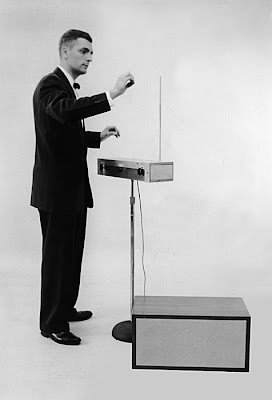
Please keep Bob's legacy alive & in your thoughts this week. You can do this by donating money to the Moog Foundation and by playing Moog instruments.
Dub:
Moogseum
Subscribe to:
Comments (Atom)
